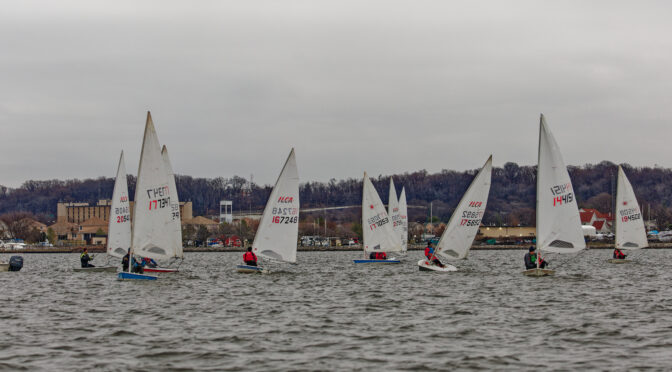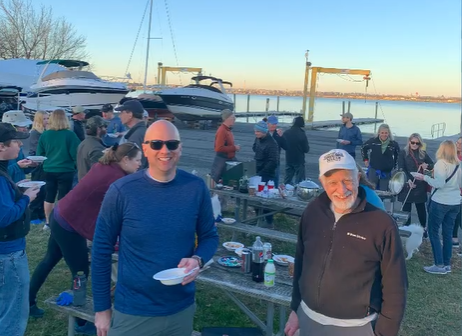If you grow up sailing on a small creek, as I did, you are no stranger to shifty winds, land bends, dead spots and downdrafts. While the Potomac is a far cry wider and wilder than Beaver Dam Creek in Point Pleasant, N.J., it was no less fickle wind-wise on New Year’s Day for the Potomac River Sailing Association Hangover Regatta, which saw a very tight fleet of 30 boats, scrambling through an oscillating breeze that seemed to switch on and off at will.
All in all, conditions were, in my opinion at least, near ideal for a frostbite regatta (though many including me, were wishing the unseasonably warm weather of the week before had stuck around for a day longer) with a nice 8-knot breeze ushering the fleet out of the marina and past the runway of Reagan International Airport and quickly building into fresher, sustained gusts.
As many of you may know, I usually sail on the Elizabeth River in Norfolk with the Hampton Roads Sailing posse. Four of us, Charlie Brewer, Britt Drake, Grant Simmons and myself schlepped it up I-95 for the regatta and by the time I arrived at 10 a.m. Charlie and Britt had built a nice little firepit with some of the river driftwood down by the boat hoists and were keeping their hands warm by the crackling fire. The out-of-towners drew a bit of amusement, but at least it took the chill off.
And it was brisk: The weather station at Reagan International Airport recorded a mean temperature for the day of 37 degrees with a maximum in the partly sunny afternoon of 47 degrees. Winds were generally SSW at about 8 mph with a maximum recorded wind speed of 21 mph and a few gusts up to 24. (There were a fair number of upturned hulls during the day for those caught out by the blasts. I got caught trying to sail deep by the lee when one of those gusts caught me. My scramble up the deck was too late, but I didn’t get wet, so I am not counting it as an actual capsize even though I brought some souvenir Potomac River bottom mud home on the head of my sail.) Charlie said he got dipped twice, once going upwind when a gust came at him behind the sail. “normally you can just hang on and it will switch back and lift you up,” Charlie said. But not that time, apparently. I spent a lot of time looking ahead (upwind) and behind (downwind) to try to read the gusts from the angles and heal of other boats. It served me pretty well as I was able to prepare for a few major onslaughts of wind before they got to me.
Race Committee Chair Nabeel Alsalam set a perfect windward-leeward course with a leeward gate and a short-leg upwind finish. Races were run twice around the course and, given the conditions, lasted about 30 minutes each. A total of five races were run and the scoring included a throw-out. Starts were run in three minute sequences with a whistle countdown, so if you are like me and sail without a watch, you were not at any significant disadvantage. (We run with three minute starts down in Norfolk, too, and it seems to be a lot better for dinghy racing, even with bigger fleets. How hard is it to choose a spot on the line and set up in a Laser, after all. And less time to get cold. If the line length is about 30 seconds, two minutes is plenty of time to run a check and commit to a strategy, I think.)
Despite the very shifty gusts, the line was very square all day, with a slight committee boat bias. This was balanced out by a slightly favored left side of the course which seemed to pay off with a bit more pressure and for those boats that went deep enough into the corner, a huge lift to the windward mark along the western shore of the river.
And that seemed to be the challenge of the day: how to tap into the shifts and very localized pressure zones. Upwind, the pressure seemed to emerge from the right, but the better lifts seemed to favor the left. A key was not to get caught in the middle too early on the course.
In the first race, both Charlie and I joined the massive fight for a spot near the committee boat and got caught up in the air sponge of sails losing whatever advantage might have been gained by the line bias and losing options to tack out in the throng of boats. After seeing the left-side boats cash in, we both found ourselves switching plans, moving down to the center of the line below the scrum and able to blast out with a clean lane. This seemed to pay off in several races as the lift back to the mark seemed to be greater the deeper out you got.
Regatta winner Charlie Brewer had another idea which twice paid dividends for him (and burned him once, too.) He ducked the entire fleet on one start to go out far to the right to try to get to the pressure lines first. He was out nearly by his lonesome and it wasn’t looking good for awhile, until he came zooming into the top mark clear ahead of the fleet with only (I believe) Eric Peterson nearby. I have seen Charlie do this before in Norfolk and his thinking is, (correct me if I am wrong, Charlie) if you are in clear air and sailing fast rather than mixing it up in the crowd you are likely to do well. The shifty conditions certainly helped that strategy. If you were attentive to the breeze you could climb the ladder pretty fast. If not, there were a lot of snakes around.
Toward the end of the day, the river current began to sweep out along the eastern shore and played an interesting role at the bottom mark. Logic seemed to dictate that if you sailed to the left (going downwind) the outgoing tide would sweep you into the gates. But that led to a more direct downwind angle which actually turned out to be slower. (In my experience on the course) Those sailing deeper to the right, sailed hotter angles at the bottom and often got a little lift of speed near the gates that squirted them forward. It worked for me, anyway, once I cottoned on. The big key downwind, I found, was just to look aft for the pressure lines on the water and try to position in front of them well ahead of their arrival. Then, work the waves and gusts building speed ahead of the waves and soaking down once the pressure is full on.
Thanks again to Potomac River Sailing Association for hosting this event and inviting your friends from the south up to take part. It was a great time and the after-race brew and chew was a lot of fun. Hope to see you next year.
Robert Suhay
2016 Hangover Regatta
Regatta Photos (courtesy of Jim Lane)



 (Photo by Lloyd Leonard)
(Photo by Lloyd Leonard)